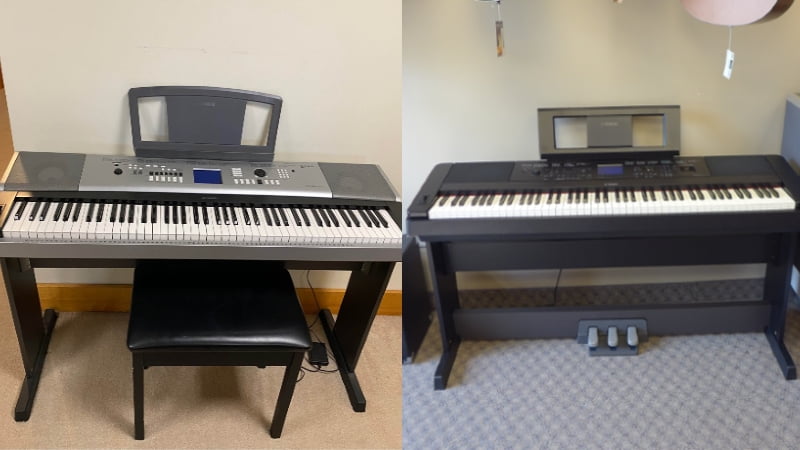Learn why the DGX-660 is the better piano in this Yamaha DGX-530 vs 660 comparison!
The Yamaha DGX line has made quite a name for itself recently. Most of its models offer great value for the money, whether you’re shopping in the entry-level or premium range. That said, with so many good pianos in the product line, finding the best one for your needs is pretty tough.
That’s why I’ve spent a lot of time comparing different DGX models. And in today’s Yamaha DGX-530 vs 660 comparison, we’re finding which one is worth the investment.
The Yamaha DGX-530 is a classic model in this collection and comes with tons of great features. On the flip side, the DGX-660 is more expensive and modern. This means that the DGX-660 comes with many more features that any pianist would love.
After testing both models, I found that the DGX-660 is the better pick. With all its features and premium build, it was hard for the DGX-530 to put up a fight.
That said, these pianos were made for different pianists, so it’s all about determining which one is the best pick for you. Below, I get into the details of both pianos so you won’t have a hard time choosing a piano suited to your needs!
Yamaha DGX-530 vs 660: Comparison Chart




Last update on 2025-04-10 / Affiliate links / Images from Amazon Product Advertising API
Yamaha DGX-530 vs 660: A Head-to-Head Comparison
I chose to compare these pianos based on three main qualities – tone, feel, and polyphony. These are the characteristics that truly make up a digital piano and are some of the most important ones to consider when buying one for yourself.
Based on these three qualities, the Yamaha DGX-660 won with a score of 3-0. Not only is this the newer pick on the market, but it’s also more expensive. So, it comes with a range of great features that you won’t find on the Yamaha DGX-530, which is why it was the winner in this in-depth comparison.
Tone
The winner: Yamaha DGX-660
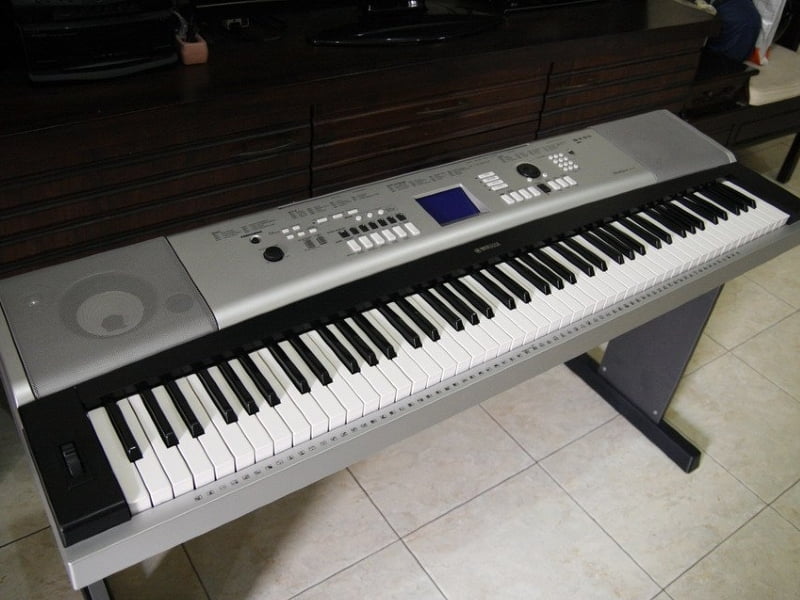
The tone is the most important feature of a digital piano. You always want to get a digital piano that sounds good and is close to an acoustic piano. And between these two models, the Yamaha DGX-660 is the easy winner.
Not only does it come with a much more realistic sound from the Pure CF Sound Engine, but it has a more varied sound library. This is about what is expected from the more expensive and modern pick, so I wasn’t surprised that the Yamaha DGX-660 took this point.
+Tone Generation
As mentioned earlier, the DGX-660 uses the Pure CF Sound Engine, which is one of the best tone generators that Yamaha has to offer. This tone engine derives its samples directly from Yamaha CF Grand Pianos, which are some of the best grand pianos on the market.
These instruments are known for their vibrant and rich sounds. And since Yamaha used the best recording equipment available to get these samples, the DGX-660 produces very crisp, clear, and realistic tones. In fact, the only Yamaha sound engine that can beat this is the CFX, which is what you’ll find on their most premium options.
The Yamaha DGX-530, on the other hand, uses the older AWM sampling method for its tones. As you can tell, this tone engine relies mostly on samples to produce its tones. And while it has pretty details and rich samples as well, it doesn’t compare to the Pure CF Sound Engine.
AWM stereo sampling is great for beginner pianos. This is because this tone generator is cost-effective while still producing fairly realistic tones. But if you’re an advanced and serious pianist needing the best tones available, the DGX-660 is the best option.
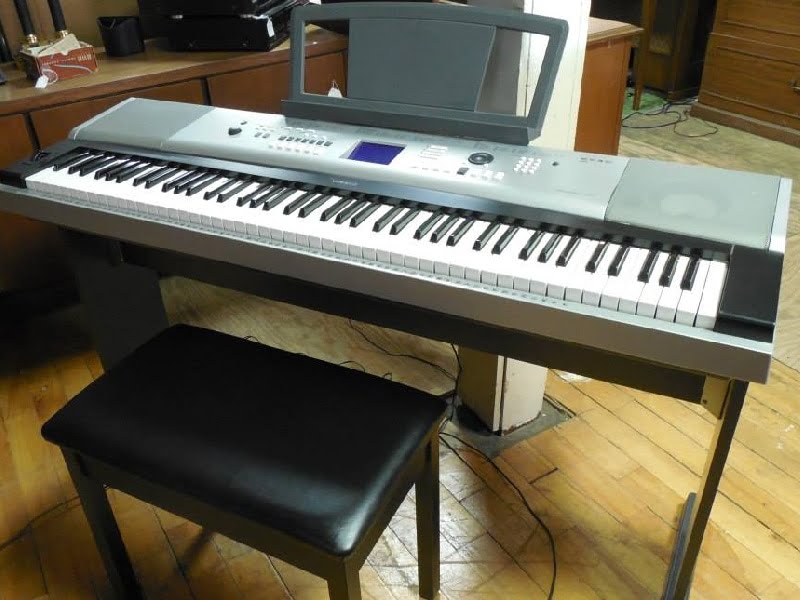
+Sound Library
The Yamaha DGX-530’s sound library is great for its price. You get more than 500 voices from this piano, which is way more variety than any other option that costs the same price. This makes it great for pianists that play different genres, as you can easily use the instrument to play the piano, organ, and even drum sounds!
That said, the DGX-530’s sound library isn’t the best quality. While you get variety, I noticed that many of the voices lack quality. They aren’t that crisp or realistic, which can give the music a digital feel. This is a major issue for advanced pianists, but if you’re a beginner, this shouldn’t be that much of a problem.
The DGX-660, on the other hand, balances both quality and quantity. It has a sound library with over 550 voices, which is a bit larger than the DGX-530. On top of that, many of the voices in this sound library are top-quality.
Granted, when I went through all the sounds on the DGX-660, I noticed that some could be a bit more realistic. But when you compare the DGX-660’s sound to the DGX-530, you will instantly notice that the DGX-660 offers better tones.
Feel
The winner: Yamaha DGX-660
The way a piano feels is also very important when shopping for a digital piano. In my opinion, the closer a digital piano feels to an acoustic piano, the better. And between the DGX-660 and the DGX-530, the former feels way more realistic. Not only does it have a better hammer action system, but it also has textured keys, giving the DGX-660 a significant advantage over the DGX-530.
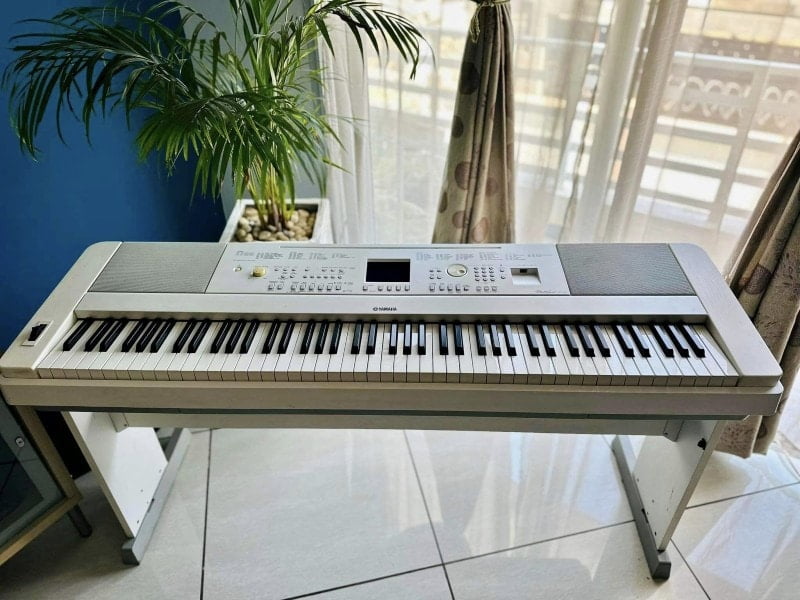
+Hammer Action
The Yamaha DGX-660 comes with a great hammer action system. This piano features the Graded Hammer Standard or GHS, which is a system that replicates the subtle weight differences on an acoustic piano’s keys. This is why when I played the DGX-660, I felt that the bass keys were a bit heavier than the treble keys.
This is a very subtle feature but an important one if you’re a serious pianist. The more you play an acoustic piano, the more you will remember the subtle weight differences between each key. This is why I am confident that the Yamaha DGX-660 is by far the better pick for experienced pianists.
On top of that, the piano doesn’t have a consistent key texture. The white keys feel glossy and plastic-like, while the black keys have a coating that resembles the texture of ebony. This gives you a textural difference that’s very important for many pianists. And while it would have been better to have a coating on both keys, at least Yamaha tried to improve the texture of the black keys on the DGX-660.
The DGX-530, on the other hand, is clearly designed for beginners. This piano has the graded soft-touch action. This means that the bass keys are still heavier than the treble keys, but none of the keys have the exact same weight that you can expect from an acoustic piano.
Additionally, the DGX-530 only features glossy plastic keys with no coating whatsoever. This is because beginners don’t exactly need the textural difference that’s on the DGX-660. The lack of coating also means that this piano is significantly more affordable than its counterparts.
That said, I would highly suggest getting the DGX-660 over the DGX-530 if you’re particular about the feel of the piano. The DGX-660 doesn’t exactly feel like an acoustic piano, but it comes much closer than any other option in its price range.
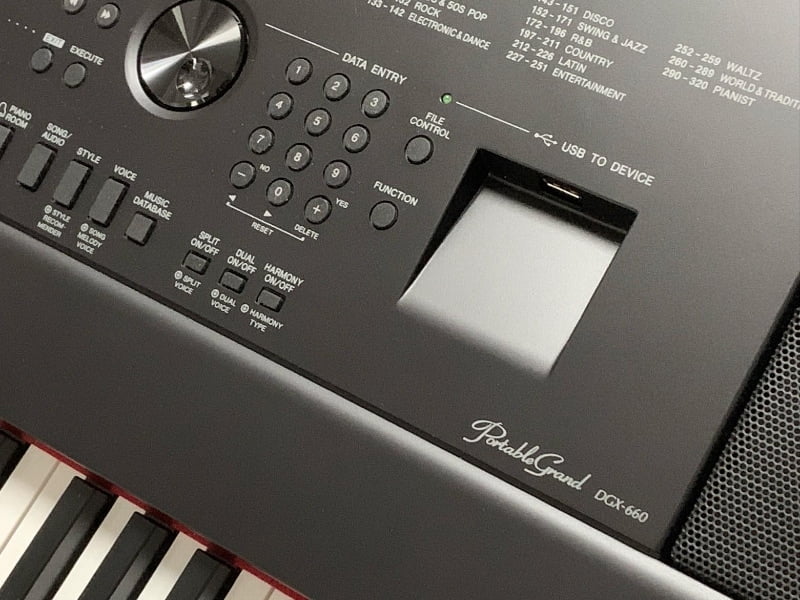
Polyphony
The winner: Yamaha DGX-660
The Yamaha DGX-660 is the clear winner regarding polyphony. As the more expensive piano, Yamaha could add more robust and advanced features. One of these features is 192-note polyphony, allowing you to play very dense chords and stack even more notes on top of that. When you play this piano, you don’t have to worry about being limited by polyphony.
On the other hand, the DGX-530 only comes with 32-note polyphony. This was a slight letdown because it’s very limiting, especially for advanced pianists. However, if you’re a beginner looking for a practice instrument, this should be more than enough.
Yamaha DGX-530 vs 660: The Similarities
These are pianos designed for different musicians. The DGX-530 is clearly geared toward beginners, while the DGX-660 is better for advanced pianists. But despite that, these pianos still share a few similarities.
To start, both pianos are portable 88-key instruments. This means you can easily load them into the trunk of your car or into a gig bag to bring to performances, lessons, and jam sessions. This is great for beginners and advanced pianists, as you can bring your instrument with you wherever you go.
Additionally, both pianos have various playing modes like split, dual, and lesson. This allows you to experiment with different sounds and play styles until you find one that fits your preferences.
And while I prefer the DGX-660, you definitely won’t go wrong with the DGX-530 if you’re a beginner.
Quick Rundown of the Yamaha DGX-530
- 88 Piano style keys with Graded Soft Touch
- 6-track recorder
- 500 high-quality tones
- Stereo Speakers, Master EQ
Last update on 2025-04-10 / Affiliate links / Images from Amazon Product Advertising API
Quick Rundown of the Yamaha DGX-660
- The Pure CF Sound Engine faithfully reproduces the tone of a meticulously sampled and highly acclaimed Yamaha concert grand piano
- GHS weighted action is heavier in the low register and lighter in the high, just like an acoustic piano
- Score display puts music notation of MIDI songs on the screen, helping you play your favorites by following the bouncing ball
- The Piano room lets you choose from a variety of pianos and acoustic settings to create your own personal piano environment
- The 6 track recorder allows you to capture your performances and song ideas, then add additional layers to spice up your pieces
Last update on 2025-04-10 / Affiliate links / Images from Amazon Product Advertising API
Product Video
Related Articles to Yamaha Dgx 660
- Yamaha YDP-164 vs DGX-660: Why You Should Go for the DGX-660
- Yamaha DGX-660 vs Roland FP-90: Why the Roland FP-90 Is the Better Pick
- Yamaha DGX-505 vs 660: Why the DGX-660 Is the Better Pick
- Yamaha DGX-660 vs DGX-640: A DGX Comparison
- Yamaha DGX-660 vs DGX-630: A DGX Comparison
- Yamaha DGX-620 vs 660: Finding the Best DGX Model
- Yamaha DGX-660 vs YDP-163: Which Is the Better Piano?
- Yamaha DGX-660 vs Roland Juno DS-88: Which Is the Better Piano?
- Yamaha DGX-660 vs Casio PX-360: Which Is the Better Piano?
- Yamaha DGX-660 vs YDP-144: Which Is the Better Yamaha Piano?
- Yamaha DGX-660 vs Korg Havian 30: Which Is the Better Digital Piano?
- Yamaha DGX-660 vs Casio CGP-700: Which Is the Better Pick?
- Yamaha DGX-660 vs YPG-535: Finding the Best Yamaha Digital Piano
- Yamaha DGX-660 vs P515: Is the P515 Worth the Extra Cost?
- Yamaha DGX-660 vs P-115: Which Yamaha Model Is Better?
- Yamaha DGX-660 vs Casio PX-560: Which Piano Offers More Value For The Money
- Yamaha DGX-660 vs 650: A DGX Comparison
- Korg XE-20 vs Yamaha DGX-660: Finding the Best Digital Piano
- Yamaha P45 Vs DGX-660: A Head-to-Head Comparison
- Yamaha DGX 670 Vs 660: The Distinct Difference In Details You Need To Know About
- Yamaha YDP-103 Vs DGX-660: Which Is The Better Yamaha Piano?
- Casio PX-770 Vs Yamaha DGX-660: Should You Get A Portable Or Console Digital Piano?
- Yamaha P71 vs DGX-660: Can the Amazon Exclusive Beat Out the Premium Model?
- Yamaha P125 vs DGX 660 Comparison: Can the P125 Hold Its Own Against the DGX 660?
References:
- Yamaha DGX-530: https://usa.yamaha.com/products/musical_instruments/pianos/portable_grand/dgx-530/specs.html
- Yamaha DGX-660: https://usa.yamaha.com/products/musical_instruments/pianos/p_series/dgx-660/index.html
Lulacruza is an electronic folk duo operating at the junction of the hypermodern and the ancient. Our music weaves together hypnotic female singing, South American folk instruments and electronic processing, while channeling pulsating waves from the source of creation.
Lalucruza is also a community where you can connect with other music lovers to collaborate, exchange ideas and share knowledge. A platform for who wants to learns the basics of playing piano, guitar, drum masters’ technique, etc.. is the premise of our website.
